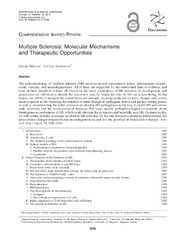Prikaz osnovnih podataka o dokumentu
Multiple Sclerosis: Molecular Mechanisms and Therapeutic Opportunities
| dc.creator | Miljković, Đorđe | |
| dc.creator | Spasojević, Ivan | |
| dc.date.accessioned | 2022-04-05T14:47:01Z | |
| dc.date.available | 2022-04-05T14:47:01Z | |
| dc.date.issued | 2013 | |
| dc.identifier.issn | 1523-0864 | |
| dc.identifier.uri | http://rimsi.imsi.bg.ac.rs/handle/123456789/731 | |
| dc.description.abstract | The pathophysiology of multiple sclerosis (MS) involves several components: redox, inflammatory/autoimmune, vascular, and neurodegenerative. All of them are supported by the intertwined lines of evidence, and none of them should be written off. However, the exact mechanisms of MS initiation, its development, and progression are still elusive, despite the impressive pace by which the data on MS are accumulating. In this review, we will try to integrate the current facts and concepts, focusing on the role of redox changes and various reactive species in MS. Knowing the schedule of initial changes in pathogenic factors and the key turning points, as well as understanding the redox processes involved in MS pathogenesis is the way to enable MS prevention, early treatment, and the development of therapies that target specific pathophysiological components of the heterogeneous mechanisms of MS, which could alleviate the symptoms and hopefully stop MS. Pertinent to this, we will outline (i) redox processes involved in MS initiation; (ii) the role of reactive species in inflammation; (iii) prooxidative changes responsible for neurodegeneration; and (iv) the potential of antioxidative therapy. Antioxid. Redox Signal. 19, 2286-2334. | en |
| dc.publisher | Mary Ann Liebert, Inc, New Rochelle | |
| dc.relation | info:eu-repo/grantAgreement/MESTD/Basic Research (BR or ON)/173014/RS// | |
| dc.relation | info:eu-repo/grantAgreement/MESTD/Basic Research (BR or ON)/173035/RS// | |
| dc.rights | openAccess | |
| dc.rights.uri | https://creativecommons.org/licenses/by/4.0/ | |
| dc.source | Antioxidants & Redox Signaling | |
| dc.subject | redox signalling | |
| dc.subject | nitric oxide | |
| dc.subject | H2O2 | |
| dc.subject | cytokine | |
| dc.subject | inflammation | |
| dc.subject | neurodegeneration | |
| dc.title | Multiple Sclerosis: Molecular Mechanisms and Therapeutic Opportunities | en |
| dc.type | article | |
| dc.rights.license | BY | |
| dc.citation.epage | 2334 | |
| dc.citation.issue | 18 | |
| dc.citation.other | 19(18): 2286-2334 | |
| dc.citation.rank | aM21 | |
| dc.citation.spage | 2286 | |
| dc.citation.volume | 19 | |
| dc.identifier.doi | 10.1089/ars.2012.5068 | |
| dc.identifier.fulltext | http://rimsi.imsi.bg.ac.rs/bitstream/id/905/728.pdf | |
| dc.identifier.pmid | 23473637 | |
| dc.identifier.scopus | 2-s2.0-84885072257 | |
| dc.identifier.wos | 000328567200007 | |
| dc.type.version | publishedVersion |

